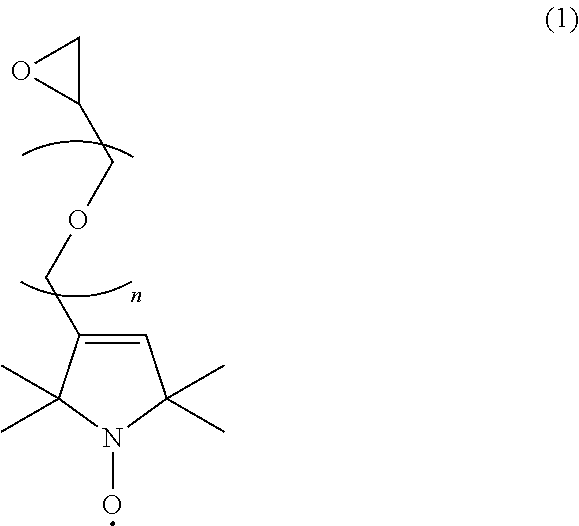Radical composition and battery using same
a technology of radio composition and battery, applied in the direction of li-accumulators, cell components, electrical equipment, etc., can solve the problems of battery performance significantly lowering, lithium ion secondary batteries often falling below the expected capacity or output, and needing to be charged, so as to suppress the elution of electrode components
- Summary
- Abstract
- Description
- Claims
- Application Information
AI Technical Summary
Benefits of technology
Problems solved by technology
Method used
Image
Examples
preparation 1
(Preparation of Pyrroline Nitroxide Compound)
[0094]A 100-mL four-neck flask equipped with a stirrer, a thermometer, a reflux condenser tube, and a flow meter was charged with 1.17 g of 3-carbamoyl-2,2,5,5-tetramethylpyrroline-1-oxyl and 16.8 mL of a 10 wt % aqueous sodium hydroxide solution. The mixture was suspended and allowed to stand for two hours at 100° C. Then, an appropriate amount of dilute hydrochloric acid was added thereto to neutralize the mixture. In this manner, a yellow solution was obtained. To the solution, 50 mL of diethyl ether was added, and the target substance was extracted from the solution by the ether. The ether was concentrated to give 1.12 g of 3-carboxy-2,2,5,5-tetramethylpyrroline-1-oxyl in the form of yellow crystals.
[0095]Because of the following properties, the obtained 3-carboxy-2,2,5,5-tetramethylpyrroline-1-oxyl could be identified.
IR (KBr): 3300, 2500, 1707 cm−1
Molecular mass (Mass analysis by atmospheric pressure ionization method): 184
[0096]An...
preparation 2
(Preparation of Pyrroline Nitroxide Compound)
[0110]A 100-mL four-neck flask equipped with a stirrer, a thermometer, a reflux condenser tube, and a flow meter was charged with 1.17 g of 3-carbamoyl-2,2,5,5-tetramethyl pyrroline-1-oxyl and 16.8 mL of a 10 wt % sodium hydroxide aqueous solution. The mixture was suspended and allowed to stand for two hours at 100° C. Then, an appropriate amount of dilute hydrochloric acid was added thereto to neutralize the mixture. In this manner, a yellow solution was obtained. To the solution, 50 mL of diethyl ether was added, and the target substance was extracted from the solution by the diethyl ether. The diethyl ether was concentrated to give 1.12 g of 3-carboxy-2,2,5,5-tetramethylpyrroline-1-oxyl in the form of yellow crystals.
[0111]Because of the following properties, the obtained 3-carboxy-2,2,5,5-tetramethylpyrroline-1-oxyl could be identified.
IR(KBr): 3300, 2500, 1707 cm−1
Molecular mass (Mass analysis by atmospheric pressure ionization meth...
example 1
[0120]An amount of 9.0 g of N-methyl-2-pyrrolidinone (NMP) was added to 1.0 g of polyvinylidene fluoride, and the polyvinylidene fluoride was dissolved to give a polyvinylidene fluoride solution.
[0121]To the solution, 0.3 g of pyrroline nitroxide polymers prepared in the same manner as in Preparation 1 and 0.015 g of polyethylene glycol (product of Sigma-Aldrich Japan, number average molecular weight of 35,000) were added. The mixture was stirred with a stirrer until uniform to give a radical composition.
[0122]To the obtained radical composition, 3.0 g of NMP and 3.0 g of the polyvinylidene fluoride solution were added. The mixture was stirred with a stirrer until uniform to give a nitroxide polymer dispersion.
[0123]To the obtained nitroxide polymer dispersion, 2.4 g of graphite powder was added as a conduction aid. The mixture was stirred with a stirrer until uniform to prepare ink for an electrode.
[0124]The obtained ink for an electrode was casted on an ITO / glass electrode substra...
PUM
| Property | Measurement | Unit |
|---|---|---|
| temperatures | aaaaa | aaaaa |
| temperature | aaaaa | aaaaa |
| temperature | aaaaa | aaaaa |
Abstract
Description
Claims
Application Information
 Login to View More
Login to View More - R&D
- Intellectual Property
- Life Sciences
- Materials
- Tech Scout
- Unparalleled Data Quality
- Higher Quality Content
- 60% Fewer Hallucinations
Browse by: Latest US Patents, China's latest patents, Technical Efficacy Thesaurus, Application Domain, Technology Topic, Popular Technical Reports.
© 2025 PatSnap. All rights reserved.Legal|Privacy policy|Modern Slavery Act Transparency Statement|Sitemap|About US| Contact US: help@patsnap.com



